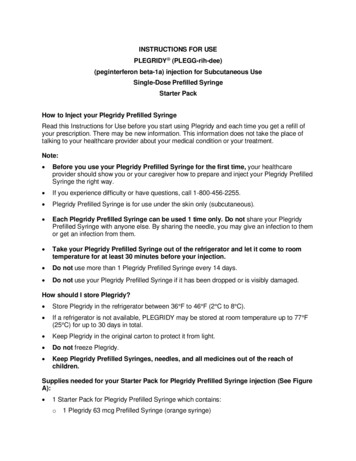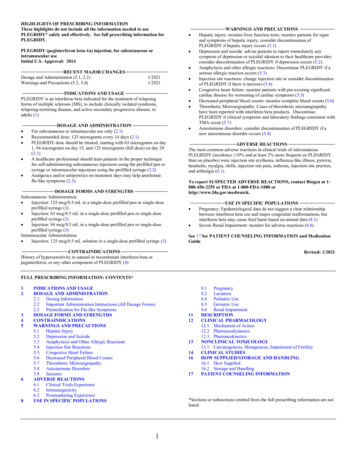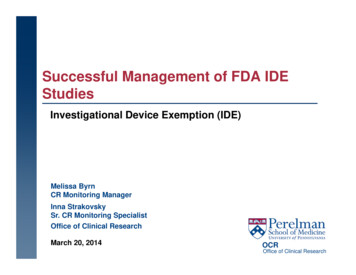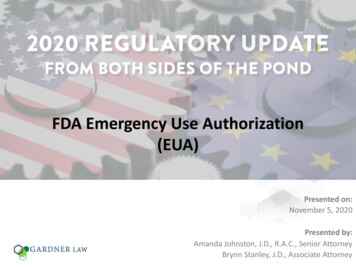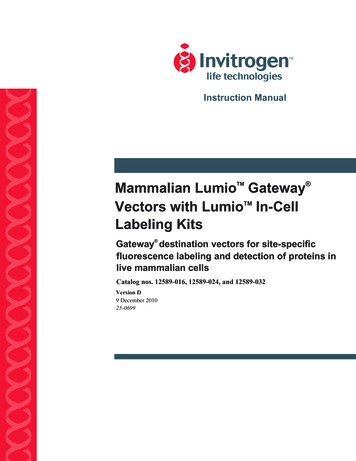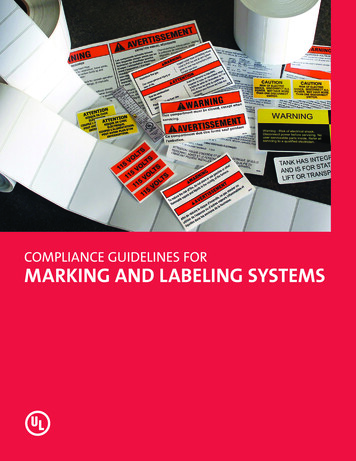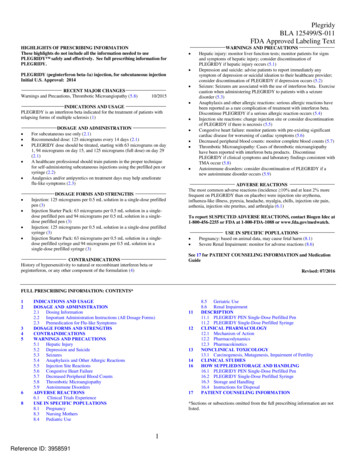
Transcription
PlegridyBLA 125499/S-011FDA Approved Labeling TextHIGHLIGHTS OF PRESCRIBING INFORMATIONThese highlights do not include all the information needed to usePLEGRIDY safely and effectively. See full prescribing information forPLEGRIDY.WARNINGS AND PRECAUTIONS PLEGRIDY (peginterferon beta-1a) injection, for subcutaneous injectionInitial U.S. Approval: 2014RECENT MAJOR CHANGESWarnings and Precautions, Thrombotic Microangiopathy (5.8)10/2015INDICATIONS AND USAGE PLEGRIDY is an interferon beta indicated for the treatment of patients withrelapsing forms of multiple sclerosis (1) DOSAGE AND ADMINISTRATION For subcutaneous use only (2.1)Recommended dose: 125 micrograms every 14 days (2.1)PLEGRIDY dose should be titrated, starting with 63 micrograms on day1, 94 micrograms on day 15, and 125 micrograms (full dose) on day 29(2.1)A healthcare professional should train patients in the proper techniquefor self-administering subcutaneous injections using the prefilled pen orsyringe (2.2)Analgesics and/or antipyretics on treatment days may help ameliorateflu-like symptoms (2.3)DOSAGE FORMS AND STRENGTHS Injection: 125 micrograms per 0.5 mL solution in a single-dose prefilledpen (3)Injection Starter Pack: 63 micrograms per 0.5 mL solution in a singledose prefilled pen and 94 micrograms per 0.5 mL solution in a singledose prefilled pen (3)Injection: 125 micrograms per 0.5 mL solution in a single-dose prefilledsyringe (3)Injection Starter Pack: 63 micrograms per 0.5 mL solution in a singledose prefilled syringe and 94 micrograms per 0.5 mL solution in asingle-dose prefilled syringe (3)CONTRAINDICATIONSHistory of hypersensitivity to natural or recombinant interferon beta orpeginterferon, or any other component of the formulation (4) Hepatic injury: monitor liver function tests; monitor patients for signsand symptoms of hepatic injury; consider discontinuation ofPLEGRIDY if hepatic injury occurs (5.1)Depression and suicide: advise patients to report immediately anysymptom of depression or suicidal ideation to their healthcare provider;consider discontinuation of PLEGRIDY if depression occurs (5.2)Seizure: Seizures are associated with the use of interferon beta. Exercisecaution when administering PLEGRIDY to patients with a seizuredisorder (5.3)Anaphylaxis and other allergic reactions: serious allergic reactions havebeen reported as a rare complication of treatment with interferon beta.Discontinue PLEGRIDY if a serious allergic reaction occurs (5.4)Injection site reactions: change injection site or consider discontinuationof PLEGRIDY if there is necrosis (5.5)Congestive heart failure: monitor patients with pre-existing significantcardiac disease for worsening of cardiac symptoms (5.6)Decreased peripheral blood counts: monitor complete blood counts (5.7)Thrombotic Microangiopathy: Cases of thrombotic microangiopathyhave been reported with interferon beta products. DiscontinuePLEGRIDY if clinical symptoms and laboratory findings consistent withTMA occur (5.8)Autoimmune disorders: consider discontinuation of PLEGRIDY if anew autoimmune disorder occurs (5.9)ADVERSE REACTIONSThe most common adverse reactions (incidence 10% and at least 2% morefrequent on PLEGRIDY than on placebo) were injection site erythema,influenza-like illness, pyrexia, headache, myalgia, chills, injection site pain,asthenia, injection site pruritus, and arthralgia (6.1)To report SUSPECTED ADVERSE REACTIONS, contact Biogen Idec at1-800-456-2255 or FDA at 1-800-FDA-1088 or www.fda.gov/medwatch.USE IN SPECIFIC POPULATIONS Pregnancy: based on animal data, may cause fetal harm (8.1) Severe Renal Impairment: monitor for adverse reactions (8.6)See 17 for PATIENT COUNSELING INFORMATION and MedicationGuideRevised: 07/2016FULL PRESCRIBING INFORMATION: CONTENTS*1234568INDICATIONS AND USAGEDOSAGE AND ADMINISTRATION2.1 Dosing Information2.2 Important Administration Instructions (All Dosage Forms)2.3 Premedication for Flu-like SymptomsDOSAGE FORMS AND STRENGTHSCONTRAINDICATIONSWARNINGS AND PRECAUTIONS5.1 Hepatic Injury5.2 Depression and Suicide5.3 Seizures5.4 Anaphylaxis and Other Allergic Reactions5.5 Injection Site Reactions5.6 Congestive Heart Failure5.7 Decreased Peripheral Blood Counts5.8 Thrombotic Microangiopathy5.9 Autoimmune DisordersADVERSE REACTIONS6.1Clinical Trials ExperienceUSE IN SPECIFIC POPULATIONS8.1 Pregnancy8.3 Nursing Mothers8.4 Pediatric Use111213141617*Sections or subsections omitted from the full prescribing information are notlisted.1Reference ID: 39585918.5 Geriatric Use8.6 Renal ImpairmentDESCRIPTION11.1 PLEGRIDY PEN Single-Dose Prefilled Pen11.2 PLEGRIDY Single-Dose Prefilled SyringeCLINICAL PHARMACOLOGY12.1 Mechanism of Action12.2 Pharmacodynamics12.3 PharmacokineticsNONCLINICAL TOXICOLOGY13.1 Carcinogenesis, Mutagenesis, Impairment of FertilityCLINICAL STUDIESHOW SUPPLIED/STORAGE AND HANDLING16.1 PLEGRIDY PEN Single-Dose Prefilled Pen16.2 PLEGRIDY Single-Dose Prefilled Syringe16.3 Storage and Handling16.4 Instructions for DisposalPATIENT COUNSELING INFORMATION
PlegridyBLA 125499/S-011FDA Approved Labeling Text2Reference ID: 3958591
PlegridyBLA 125499/S-011FDA Approved Labeling TextFULL PRESCRIBING INFORMATION1INDICATIONS AND USAGEPLEGRIDY (peginterferon beta-1a) is indicated for the treatment of patients with relapsingforms of multiple sclerosis.2DOSAGE AND ADMINISTRATION2.1Dosing InformationPLEGRIDY is administered subcutaneously.The recommended dosage of PLEGRIDY is 125 micrograms injected subcutaneously every 14days.Treatment initiationPatients should start treatment with 63 micrograms on day 1. On day 15 (14 days later), the doseis increased to 94 micrograms, reaching the full dose of 125 micrograms on day 29 (after another14 days). Patients continue with the full dose (125 micrograms) every 14 days thereafter (seeTable 1). A PLEGRIDY Starter Pack is available containing two prefilled pens or syringes: 63micrograms (dose 1) and 94 micrograms (dose 2).Table 1:Schedule for Dose TitrationDoseTime*Amount (micrograms)Color of Pen orSyringe LabelDose 1On day 163OrangeDose 2On day 1594BlueDose 3On day 29 and every 14days thereafter125 (full dose)Grey*Dosed every 14 days2.2Important Administration Instructions (All Dosage Forms)Healthcare professionals should train patients in the proper technique for self-administeringsubcutaneous injections using the prefilled pen or syringe. Patients should be advised to rotatesites for subcutaneous injections. The usual sites for subcutaneous injections are abdomen, backof the upper arm, and thigh.Each PLEGRIDY pen and syringe is provided with the needle pre-attached. Prefilled pens andsyringes are for a single dose only and should be discarded after use.3Reference ID: 3958591
PlegridyBLA 125499/S-011FDA Approved Labeling Text2.3Premedication for Flu-like SymptomsProphylactic and concurrent use of analgesics and/or antipyretics may prevent or ameliorate flulike symptoms sometimes experienced during treatment with PLEGRIDY.3DOSAGE FORMS AND STRENGTHSPen Injection: 125 micrograms of PLEGRIDY per 0.5 mL of solution in a single-dose prefilledpen Injection: Starter Pack containing 63 micrograms per 0.5 mL of solution in a single-doseprefilled pen and 94 micrograms per 0.5 mL solution in a single-dose prefilled penPrefilled Syringe Injection: 125 micrograms of PLEGRIDY per 0.5 mL of solution in a single-dose prefilledsyringe Injection: Starter Pack containing 63 micrograms per 0.5 mL of solution in a single-doseprefilled syringe and 94 micrograms per 0.5 mL of solution in a single-dose prefilled syringe4CONTRAINDICATIONSPLEGRIDY is contraindicated in patients with a history of hypersensitivity to natural orrecombinant interferon beta or peginterferon, or any other component of the formulation [seeWarnings and Precautions (5.4)].5WARNINGS AND PRECAUTIONS5.1Hepatic InjurySevere hepatic injury, including hepatitis, autoimmune hepatitis, and rare cases of severe hepaticfailure, have been reported with interferon beta. Asymptomatic elevation of hepatictransaminases has also been reported, and in some patients has recurred upon rechallenge withinterferon beta.Elevations in hepatic enzymes and hepatic injury have been observed with the use ofPLEGRIDY in clinical studies. The incidence of increases in hepatic transaminases was greaterin patients taking PLEGRIDY than in those taking placebo. The incidence of elevations ofalanine aminotransferase above 5 times the upper limit of normal was 1% in placebo-treatedpatients and 2% in PLEGRIDY-treated patients. The incidence of elevations of aspartateaminotransferase above 5 times the upper limit of normal was less than 1% in placebo-treatedpatients and less than 1% in PLEGRIDY-treated patients. Elevations of serum hepatic4Reference ID: 3958591
PlegridyBLA 125499/S-011FDA Approved Labeling Texttransaminases combined with elevated bilirubin occurred in 2 patients. Both cases resolvedfollowing discontinuation of PLEGRIDY.Monitor patients for signs and symptoms of hepatic injury.5.2Depression and SuicideDepression, suicidal ideation, and suicide occur more frequently in patients receiving interferonbeta than in patients receiving placebo.In clinical studies, the overall incidence of adverse events related to depression and suicidalideation in multiple sclerosis patients was 8% in both the PLEGRIDY and placebo groups. Theincidence of serious events related to depression and suicidal ideation was similar and less than1% in both groups.Advise patients to report immediately any symptom of depression or suicidal ideation to theirhealthcare provider. If a patient develops depression or other severe psychiatric symptoms,consider stopping treatment with PLEGRIDY.5.3SeizuresSeizures are associated with the use of interferon beta.The incidence of seizures in multiple sclerosis clinical studies was less than 1% in patientsreceiving PLEGRIDY and placebo.Exercise caution when administering PLEGRIDY to patients with a seizure disorder.5.4Anaphylaxis and Other Allergic ReactionsAnaphylaxis and other serious allergic reactions are rare complications of treatment withinterferon beta.Less than 1% of PLEGRIDY-treated patients experienced a serious allergic reaction such asangioedema or urticaria. Those who did have serious allergic reactions recovered promptly aftertreatment with antihistamines or corticosteroids.Discontinue PLEGRIDY if a serious allergic reaction occurs.5.5Injection Site ReactionsInjection site reactions, including injection site necrosis, can occur with the use of subcutaneousinterferon beta.In clinical studies, the incidence of injection site reactions (e.g., injection site erythema, pain,pruritus, or edema) was 66% in the PLEGRIDY group and 11% in the placebo group; theincidence of severe injection site reactions was 3% in the PLEGRIDY group and 0% in theplacebo group. One patient out of 1468 patients who received PLEGRIDY in clinical studiesexperienced injection site necrosis. The injury resolved with standard medical treatment.Decisions to discontinue therapy following necrosis at a single injection site should be based onthe extent of the necrosis. For patients who continue therapy with PLEGRIDY after injection5Reference ID: 3958591
PlegridyBLA 125499/S-011FDA Approved Labeling Textsite necrosis has occurred, avoid administration of PLEGRIDY near the affected area until it isfully healed. If multiple lesions occur, discontinue PLEGRIDY until healing occurs.5.6Congestive Heart FailureCongestive heart failure, cardiomyopathy, and cardiomyopathy with congestive heart failureoccur in patients receiving interferon beta.In clinical studies, the incidence of cardiovascular events was 7% in both PLEGRIDY andplacebo treatment groups. No serious cardiovascular events were reported in the PLEGRIDYgroup.Monitor patients with significant cardiac disease for worsening of their cardiac condition duringinitiation and continuation of treatment with PLEGRIDY.5.7Decreased Peripheral Blood CountsInterferon beta can cause decreased peripheral blood counts in all cell lines, including rareinstances of pancytopenia and severe thrombocytopenia.In clinical studies, decreases in white blood cell counts below 3.0 x 109/L occurred in 7% ofpatients receiving PLEGRIDY and in 1% receiving placebo. There is no apparent associationbetween decreases in white blood cell counts and an increased risk of infections or seriousinfections. The incidence of clinically significant decreases in lymphocyte counts (below 0.5 x109/L), neutrophil counts (below 1.0 x 109/L), and platelet counts (below 100 x 109/L) were allless than 1% and similar in both placebo and PLEGRIDY groups. Two serious cases werereported in patients treated with PLEGRIDY: one patient (less than 1%) experienced severethrombocytopenia (defined as a platelet count less than or equal to 10 x 109/L), and anotherpatient (less than 1%) experienced severe neutropenia (defined as a neutrophil count less than orequal to 0.5 x 109/L). In both patients, cell counts recovered after discontinuation ofPLEGRIDY. Compared to placebo, there were no significant differences in red blood cell countsin patients treated with PLEGRIDY.Monitor patients for infections, bleeding, and symptoms of anemia. Monitor complete blood cellcounts, differential white blood cell counts, and platelet counts during treatment withPLEGRIDY. Patients with myelosuppression may require more intensive monitoring of bloodcell counts.5.8Thrombotic MicroangiopathyCases of thrombotic microangiopathy (TMA), including thrombotic thrombocytopenicpurpura and hemolytic uremic syndrome, some fatal, have been reported with interferonbeta products. Cases have been reported several weeks to years after starting interferonbeta products. Discontinue PLEGRIDY if clinical symptoms and laboratory findings consistentwith TMA occur, and manage as clinically indicated.6Reference ID: 3958591
PlegridyBLA 125499/S-011FDA Approved Labeling Text5.9Autoimmune DisordersAutoimmune disorders of multiple target organs including idiopathic thrombocytopenia, hyperand hypothyroidism, and autoimmune hepatitis have been reported with interferon beta.In clinical studies, the incidence of autoimmune disorders was less than 1% in both PLEGRIDYand placebo treatment groups.If patients develop a new autoimmune disorder, consider stopping PLEGRIDY.6ADVERSE REACTIONSThe following serious adverse reactions are discussed in more detail in other sections of labeling: Hepatic Injury [see Warnings and Precautions (5.1)] Depression and Suicide [see Warnings and Precautions (5.2)] Seizures [see Warnings and Precautions (5.3)] Anaphylaxis and Other Allergic Reactions [see Warnings and Precautions (5.4)] Injection Site Reactions [see Warnings and Precautions (5.5)] Congestive Heart Failure [see Warnings and Precautions (5.6)] Decreased Peripheral Blood Counts [see Warnings and Precautions (5.7)] Thrombotic Microangiopathy [see Warnings and Precautions (5.8)] Autoimmune Disorders [see Warnings and Precautions (5.9)]6.1Clinical Trials ExperienceBecause clinical trials are conducted under widely varying conditions, adverse reaction ratesobserved in the clinical trials of PLEGRIDY cannot be directly compared to rates in clinicaltrials of other drugs and may not reflect the rates observed in practice.In clinical studies (Study 1 and Study 2), a total of 1468 patients with relapsing multiple sclerosisreceived PLEGRIDY for up to 177 weeks (41 months), with an overall exposure equivalent to1932 person-years. A total of 1093 patients received at least 1 year, and 415 patients at least 2years of treatment with PLEGRIDY. A total of 512 and 500 patients, respectively, receivedPLEGRIDY 125 micrograms every 14 days or every 28 days during the placebo-controlledphase of Study 1 (year 1). The experience in year 2 of Study 1 and in the 2-year safety extensionstudy (Study 2) was consistent with the experience in the 1-year placebo-controlled phase ofStudy 1.In the placebo-controlled phase of Study 1, the most common adverse drug reactions forPLEGRIDY 125 micrograms subcutaneously every 14 days were injection site erythema,influenza-like illness, pyrexia, headache, myalgia, chills, injection site pain, asthenia, injectionsite pruritus, and arthralgia (all had incidence more than 10% and at least 2% more thanplacebo). The most commonly reported adverse event leading to discontinuation in patients7Reference ID: 3958591
PlegridyBLA 125499/S-011FDA Approved Labeling Texttreated with PLEGRIDY 125 micrograms subcutaneously every 14 days was influenza-likeillness (in less than 1% of patients).Table 2 summarizes adverse reactions reported over 48 weeks from patients treated in theplacebo-controlled phase of Study 1 who received subcutaneous PLEGRIDY 125 micrograms(n 512), or placebo (n 500), every 14 days.8Reference ID: 3958591
Table 2:PlegridyBLA 125499/S-011FDA Approved Labeling TextAdverse reactions in the 48-week placebo-controlled phase of Study 1 with anincidence 2% higher for PLEGRIDY than for placeboPLEGRIDY(N 512)%Placebo(N 500)%Nervous System DisordersHeadache4433Gastrointestinal DisordersNausea96Vomiting52Musculoskeletal and Connective TissueDisordersMyalgia196Arthralgia117General Disorders and Administration SiteConditionsInjection site erythemaInfluenza like illness6247713Pyrexia4515ChillsInjection site pain171553Asthenia138Injection site pruritus131HyperthermiaPain4513Injection site edema30Injection site warmth30Injection site hematoma31Injection site rash20InvestigationsBody temperature increasedAlanine aminotransferase increased6633Aspartate aminotransferase increased42Gamma-glutamyl-transferase increased3141Skin and Subcutaneous Tissue DisorderPruritus9Reference ID: 3958591
PlegridyBLA 125499/S-011FDA Approved Labeling TextImmunogenicityFor therapeutic proteins, there is a potential for immunogenicity. In Study 1, fewer than 1% ofpatients treated with PLEGRIDY every 14 days for 1 year developed neutralizing antibodies.Approximately 7% of PLEGRIDY-treated patients developed antibodies to PEG.The detection of antibody formation is highly dependent on the sensitivity and specificity of theassay. Additionally, the observed incidence of antibody (including neutralizing antibody)positivity in an assay may be influenced by several factors including assay methodology, samplehandling, timing of sample collection, concomitant medications, and underlying disease. Forthese reasons, comparison of the incidence of antibodies to PLEGRIDY with the incidence ofantibodies to other products may be misleading.Flu-Like SymptomsInfluenza-like illness was experienced by 47% of patients receiving PLEGRIDY 125micrograms every 14 days and 13% of patients receiving placebo. Fewer than 1% ofPLEGRIDY-treated patients in Study 1 discontinued treatment due to flu-like symptoms.8USE IN SPECIFIC POPULATIONS8.1PregnancyPregnancy Category CThere are no adequate and well-controlled studies in pregnant women. PLEGRIDY should beused during pregnancy only if the potential benefit justifies the potential risk to the fetus.PLEGRIDY has not been tested for developmental toxicity in pregnant animals. In monkeysgiven interferon beta by subcutaneous injection every other day during early pregnancy, noteratogenic or other adverse effects on fetal development were observed. Abortifacient activitywas evident following 3 to 5 doses.Pregnancy Exposure RegistryThere is a pregnancy exposure registry that monitors pregnancy outcomes in women exposed toPLEGRIDY during pregnancy. Encourage patients to enroll by calling 1-866-810-1462 orvisiting ing MothersIt is not known whether this drug is excreted in human milk. Because many drugs are excretedin human milk, caution should be exercised when PLEGRIDY is administered to a nursingwoman.8.4Pediatric UseSafety and effectiveness in pediatric patients have not been established.10Reference ID: 3958591
PlegridyBLA 125499/S-011FDA Approved Labeling Text8.5Geriatric UseSafety and effectiveness in geriatric patients have not been established.8.6Renal ImpairmentMonitor for adverse reactions due to increased drug exposure in patients with severe renalimpairment [see Clinical Pharmacology (12.3)].11DESCRIPTIONPLEGRIDY (peginterferon beta-1a) is an interferon beta-1a to which a single, linear 20,000dalton (Da) methoxy poly(ethyleneglycol)-O-2-methylpropionaldehyde molecule is covalentlyattached to the alpha amino group of the N-terminal amino acid residue.The interferon beta-1a portion of PLEGRIDY is produced as a glycosylated protein usinggenetically-engineered Chinese hamster ovary cells into which the human interferon beta genehas been introduced. The amino acid sequence of the recombinant interferon beta-1a is identicalto that of the human interferon beta counterpart. The molecular mass of PLEGRIDY isapproximately 44,000 Da, consistent with the mass of the protein (approximately 20,000 Da), thecarbohydrate moieties (approximately 2,500 Da), and the attached poly(ethylene glycol).However, because of the extended and flexible nature of the attached poly(ethylene glycol)chain, the apparent mass of PLEGRIDY in solution is greater than 300,000 Da. The more than10-fold increase in apparent mass of PLEGRIDY compared to interferon beta-1a has been shownto contribute to the reduced clearance in vivo.PLEGRIDY 125 micrograms contains 125 micrograms of interferon beta-1a plus 125micrograms of poly(ethylene glycol). Using the World Health Organization InternationalStandard for interferon beta, PLEGRIDY has a specific antiviral activity of approximately 100million International Units (MIU) per mg of protein as determined using an in vitro cytopathiceffect assay. PLEGRIDY 125 micrograms contains approximately 12 MIU of antiviral activity.PLEGRIDY contains no preservative.11.1PLEGRIDY PEN Single-Dose Prefilled PenPLEGRIDY PEN is composed of an autoinjector that surrounds a prefilled glass syringecontaining 0.5 mL of a sterile solution in water for injection of 63, 94, or 125 micrograms ofpeginterferon beta-1a, 15.8 mg of L-arginine HCl, 0.79 mg of sodium acetate trihydrate, 0.25 mgof glacial acetic acid, and 0.025 mg of polysorbate 20. The pH is approximately 4.8.11.2PLEGRIDY Single-Dose Prefilled SyringeA prefilled syringe of PLEGRIDY for subcutaneous injection contains 0.5 mL of a sterilesolution in water for injection of 63, 94, or 125 micrograms of peginterferon beta-1a, 15.8 mg ofL-arginine HCl, 0.79 mg of sodium acetate trihydrate, 0.25 mg of glacial acetic acid, and 0.025mg of polysorbate 20. The pH is approximately 4.8.11Reference ID: 3958591
PlegridyBLA 125499/S-011FDA Approved Labeling Text12CLINICAL PHARMACOLOGY12.1Mechanism of ActionThe mechanism by which PLEGRIDY exerts its effects in patients with multiple sclerosis isunknown.12.2PharmacodynamicsThere is no biochemical or physiologic effect known to relate directly to the clinical effect ofPLEGRIDY.12.3PharmacokineticsAfter single-dose or multiple-dose subcutaneous administration of PLEGRIDY to healthysubjects, serum PLEGRIDY peak concentration (Cmax) and total exposure over time (area underthe curve, or AUC) increased in proportion to doses from 63 to 188 micrograms. PLEGRIDYdid not accumulate in the serum after multiple doses of 125 micrograms every 14 days.Pharmacokinetic parameters for PLEGRIDY, including Cmax and AUC, did not differsignificantly between healthy volunteers and multiple sclerosis patients or between single-doseand multiple-dose administrations. However, the coefficient of variation between individualpatients for AUC, Cmax, and half-life was high (41% to 68%, 74% to 89%, and 45% to 93%,respectively).AbsorptionAfter 125 microgram subcutaneous doses of PLEGRIDY in multiple sclerosis patients, themaximum concentration occurred between 1 and 1.5 days, the mean Cmax was 280 pg/mL, andthe AUC over the 14 day dosing interval was 34.8 ng.hr/mL.DistributionIn multiple sclerosis patients taking 125 microgram subcutaneous doses of PLEGRIDY every 14days, the estimated volume of distribution was 481 liters.Metabolism and EliminationClearance mechanisms for PLEGRIDY include catabolism and excretion. The major pathway ofelimination is renal. The half-life is approximately 78 hours in multiple sclerosis patients. Themean steady state clearance of PLEGRIDY is approximately 4.1 L/hr. PLEGRIDY is notextensively metabolized in the liver.Specific PopulationsBody weight, gender, and age do not require dosage adjustment.Renal impairment can increase the Cmax and AUC for PLEGRIDY. Results of a pharmacokineticstudy in patients with mild, moderate, and severe renal impairment (creatinine clearance 50 to80, 30 to 50, and less than 30 mL/minute, respectively) showed increases above normal for Cmaxof 27%, 26%, and 42%, and for AUC, increases of 30%, 40%, and 53%. The half-life was 53,49, and 82 hours in patients with mild, moderate, and severe renal impairment, respectively,compared to 54 hours in normal subjects.12Reference ID: 3958591
PlegridyBLA 125499/S-011FDA Approved Labeling TextIn the same study, subjects with end stage renal disease requiring hemodialysis two or threetimes weekly had AUC and Cmax of PLEGRIDY values that were similar to those of normalcontrols. Each hemodialysis session removed approximately 24% of circulating PLEGRIDYfrom the systemic circulation [see Use in Specific Populations (8.6)].13NONCLINICAL TOXICOLOGY13.1Carcinogenesis, Mutagenesis, Impairment of FertilityCarcinogenesisThe carcinogenic potential of PLEGRIDY has not been tested in animals.MutagenesisPLEGRIDY was not mutagenic when tested in an in vitro bacterial reverse mutation (Ames) testand was not clastogenic in an in vitro assay in human lymphocytes.Impairment of FertilityIn monkeys administered interferon beta by subcutaneous injection over the course of onemenstrual cycle, menstrual irregularities, anovulation, and decreased serum progesterone levelswere observed. These effects were reversible after discontinuation of drug.14CLINICAL STUDIESThe efficacy of PLEGRIDY was demonstrated in the randomized, double-blind, and placebocontrolled phase (year 1) of Study 1. The trial compared clinical and MRI outcomes at 48 weeksin patients who received PLEGRIDY 125 micrograms (n 512) or placebo (n 500) by thesubcutaneous route, once every 14 days.Study 1 enrolled patients who had a baseline Expanded Disability Status Scale (EDSS) scorefrom 0 to 5, who had experienced at least 2 relapses within the previous three years, and hadexperienced at least 1 relapse in the previous year. The trial excluded patients with progressiveforms of multiple sclerosis. The mean age of the study population was 37 years, the meandisease duration was 3.6 years, and the mean EDSS score at baseline was 2.46. The majority ofthe patients were women (71%).The trial scheduled neurological evaluations at baseline, every 12 weeks, and at the time of asuspected relapse. Brain MRI evaluations were scheduled at baseline, week 24, and week 48.The primary outcome was the annualized relapse rate over 1 year. Secondary outcomes includedthe proportion of patients relapsing, number of new or newly enlarging T2 hyperintense lesions,and time to confirmed disability progression. Confirmed disability progression was defined asfollows: if the baseline EDSS score was 0, a sustained 12-week increase in EDSS score of 1.5points was required; if the baseline EDSS score was greater than 0, a sustained 12-week increasein EDSS score of 1 point was required. Table 3 and Figure 1 show the results of Study 1.13Reference ID: 3958591
PlegridyBLA 125499/S-011FDA Approved Labeling TextTable 3: Clinical and MRI Results of Study 1EndpointPLEGRIDY125 microgramsevery 14 daysPlaceboN 512N 500Annualized relapse rate0.260.400.0007Relative reduction36%0.290.00030.110.0383Clinical outcomes at 48 weeksProportion of patients with relapses0.19Relative risk reduction39%Proportion of patients with disability progression0.07Relative risk reduction38%MRI outcomes at 48 weeksMean number of new or newly enlarging T2hyperintense lesionsRelative reductionN 457N 4763.610.9 0.00011.4 0.000167%Mean number of Gd enhancing lesions0.2Relative reduction86%14Reference ID: 3958591p-value
PlegridyBLA 125499/S-011FDA Approved Labeling TextFigure 1:Time to first relapsePercentage of Patients with 0Baseline12243648363389280318Time on Study (Weeks)Number of Subjects at RiskPlaceboPLEGRIDY500512448458398414PLEGRIDY 125 mcg every 14 days (n 512) versus placebo (n 500) Hazard Ratio (95% CI) 0.61(0.47, 0.80),p 0.000316HOW SUPPLIED/STORAGE AND HANDLINGPLEGRIDY is supplied as a sterile, clear liquid for subcutaneous injection in two presentations,a prefilled pen and a prefilled syringe.16.1PLEGRIDY PEN Single-Dose Prefilled PenEach dose of PLEGRIDY is stored in a 1 mL capacity glass syringe with a rubber stopper andrigid needle shield. A 29 gauge, 0.5 inch staked needle is pre-affixed to the syringe. A singleprefilled syringe contains 0.5 mL of solution of PLEGRIDY containing 63 micrograms, 94micrograms, or 125 micrograms of peginterferon beta-1a. The glass syringe is contained within15Reference ID: 3958591
PlegridyBLA 125499/S-011FDA Approved Labeling Texta single-dose, disposable, injection device (prefilled pen). The following packagingconfigurations are available: A carton containing two single-dose prefilled pens, each providing 125 micrograms ofPLEGRIDY. The NDC is 64406-011-01. A Starter Pack carton containing two single-dose prefilled pens; dose 1 provides 63micrograms of PLEGRIDY, and dose 2 provides 94 micrograms of PLEGRIDY. The NDCis 64406-012-01.16.2PLEGRIDY Single-Dose Prefilled SyringeEach dose of PLEGRIDY is stored in a 1 mL capacity glass syringe with a rubber stopper andrigid needle shield. A 29 gauge, 0.5 inch staked needle is pre-affixed to the syringe. A singleprefilled syringe contains 0.5 mL of solution of PLEGRIDY containing 63 micrograms, 94micrograms, or 125 m
See full prescribing information for PLEGRIDY. PLEGRIDY (peginterferon beta-1a) injection, for subcutaneous injection Initial U.S. Approval: 2014 . RECENT MAJOR CHANGES . Warnings and Precautions, Thrombotic Microangiopathy (5.8) 10/2015 . INDICATIONS AND USAGE . PLEGRIDY is an interferon beta indicated for the treatment of patients with

